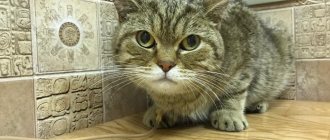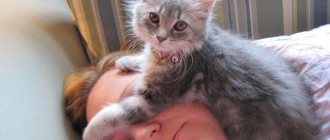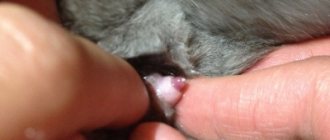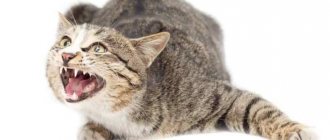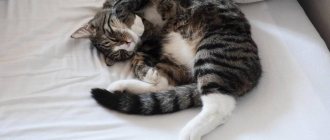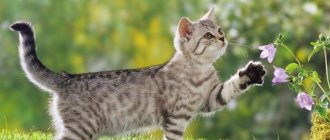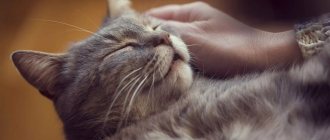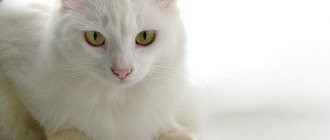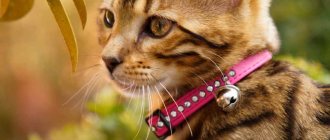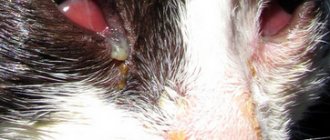Cats are perhaps the most popular pets. They improve your mood, calm your nerves and, they say, sometimes even heal. However, this is not all the skills of domestic fluffies - they can predict the weather.
Of course, your beloved cat is not a thermometer or barometer to measure temperature/pressure with an accuracy of 1 degree/millimeter of mercury. All representatives of the cat family are able to predict weather changes (especially sudden ones) - by observing their behavior, you can understand when it will rain, snow (blizzard) or severe frost will hit.
We recommend reading: Why tripping on your right and left foot: the meaning of this folk sign
What allows a cat to know the weather?
Folk signs have scientific confirmation. Scientists do not fully understand the mechanisms that allow a cat to react to upcoming warming or cooling, precipitation or strong winds.
Read also: Pig weight table by measurements
The researchers suggest that:
- due to the increased sensitivity of the inner ear and eardrum when atmospheric pressure changes, the cat tries to get rid of the unpleasant sensations and rubs the ear with its paw, washing it;
- our pet’s stomach also reacts to changes in atmospheric pressure and this forces him to drink more water and eat grass;
- the skin of your beloved pussy is sensitive to fluctuations in air humidity, this affects behavior: the cat can curl up in a ball or spread out like a rug.
Perhaps these mechanisms allow pets to reliably broadcast the weather forecast to the outside world. Or maybe there is something else - cats are the most mysterious of the creatures living with humans.
How cats predict the weather
Meowing pets sense a person's mood very well, but they are also sensitive to things that a person cannot hear or see. Observations of animals over the centuries have led to the conclusion that cats can predict the weather. Changes in behavior before bad weather can also be observed in pets today.
At certain periods of history, cats were exterminated for their ability to predict the weather, believing that they were the ones who brought terrible hurricanes, tornadoes, and storms. For example, in the old days, people thought that cats could use their tails to cause thunderstorms and rain, so they cut off the animals’ tails.
Video: Cat weather
Bagel the cat predicts the weather
You might be interested in reading:
- FUNNY CAT MATRIX 09.26.2014 How many pleasant moments our beloved pets bring us! ...
- A VET TO THE VETERINARIAN. PHOTO... 08.20.2014 It’s good if a trip to the veterinarian with your beloved pet happens once...
- OUR GUEST MUKHTARKA 01/23/2015 We recently got a new neighbor, Mukhtarka. Our …
- EVERYONE LOVES ICE CREAM! 08/05/2014 I won’t be wrong if I say that everyone loves ice cream! [caption id=»attachment_10384″ align=»aligncenter» …
- FROM THE LIFE OF PETS 02/13/2015 Pets - cats, dogs, hamsters, mice, parrots - our favorites, have been living for a long time ...
Examples of weather predictions by cats
A striking example is the case in Oklahoma, where tornadoes are a frequent occurrence. In one family there lived a cat named Sally, her usual day began with playing in the early morning, eating and sleeping during the day. But one sunny day, Sally behaved anxiously, walked around the rooms and corridors, meowing pitifully, the animal tried to get out of the house, scratching the window frame, run out the open door, and hide under the bed. Sally hissed when her owners tried to pet her. The owners paid attention to the pet’s behavior and checked the weather forecast. They learned that another tornado was approaching. Fortunately, the tornado passed by, although it was not without strong winds and rain.
In regions where earthquakes often occur, residents notice sudden changes in the behavior of cats, which before an earthquake begin to meow loudly, tremble, and seek shelter. The appearance of the animals also indicates imminent disaster - tousled fur, ears pressed to the head. Scientists theorize that animals sense an increase in static electricity that precedes an earthquake.
In the 17th and 18th centuries, sailors took cats on board their ships before sailing. With the approaching storm, the cats instinctively tried to find a safe place, anxiously leaving the ship. The sailors observed changes in the animals' behavior and took the unusual weather warning seriously. Sometimes sailors refused to go out to sea if cats escaped from the ship. It was believed that if an animal meows loudly, then a difficult swim is ahead. But the playful behavior of the animals on board the ship indicated an easy journey with good winds. Japanese sailors value individuals of tortoiseshell and white color, which are a kind of amulet against storms. Animals are credited with the ability to calm the storm.
Who is more accurate?
According to observations, a more accurate picture of immediate changes in the weather is given by cats that walk in the yard during the day and eat and sleep at home.
They have a well-developed instinct of self-preservation and their receptors for communication with the environment are more active. It is easier to watch pussies that are always at home, but spoiled by constant attention, they can arch their backs, roll on the floor, and purr loudly simply with pleasure. It is better to look at them in a dream, paying attention to the duration of sleep, posture, and sounds.
We also recommend reading:
The largest dog breeds What is domestication in animal husbandry Why you should get a cat: reasons voiced by scientists Euthanasia of animals
Any cat reacts violently to serious disasters, storms, earthquakes, storms, floods and the like. The individuality in the behavior of your beloved charges must also be taken into account, the owners always know this.
How our ancestors treated cats
From the numerous works of Russian classics, the image of cats is often formed as the embodiment of the devil on earth, the servants of witches and other evil spirits. Is it really?
In part, yes, this idea of four-legged friends came in the era of active use of spiritualism - communication with spirits, the outbreak of which occurred at the end of the 18th - beginning of the 19th centuries. Back then, even live cats were used for some rituals. But was it always like this?
Much earlier, during the times of the ancient Slavs and Kievan Rus, cats occupied their niche in the formation of many folk signs and beliefs. Of course, even then black cats were considered “servants of the evil spirit” and were feared in every possible way, but there was no such excitement around cute animals. The cat was considered a full-fledged resident of the house and the keeper of the family hearth.
Stay at home!
Such unpleasant unpleasant atmospheric phenomena as strong winds and snowstorms are usually accompanied by a sharp jump in atmospheric pressure, which cats feel much better than people. The sensations that she experiences are comparable to those we feel on an airplane - her ears are blocked.
Of course, this gives the cat little pleasure, and therefore she begins to behave restlessly: she spins around in her sleep, constantly changing her position, she can nervously sharpen her claws on the carpet or furniture, run around the room, jumping on all the heights.
It will be warm
Warming is indicated by the posture of a cat during sleep.
The warmer the days ahead, the more the animal “unfolds.” The darling forms an arc of approximately 270° before warming slightly. A pose in the shape of a semicircle indicates a sudden onset of heat. Sunny, hot weather should be expected if the cat's curl is completely unfurled. At the same time, cats stick out their tummy. While waiting for the sun, the cat often sits on the windowsill and looks out the window with interest. It can also wash the hair on the head and behind the ears with its paw.
Cats and natural disasters
There are many known cases where a cat warns its family of impending danger. Residents of earthquake-prone areas often notice that before an earthquake, animals become restless, try to find shelter, ask to go outside, become excited and press their ears to their heads. Animals often meow for no reason, trying to tell their owner that something is wrong. The most weather-dependent individuals leave their homes several days before the disaster.
Scientists explain this behavior by the increased sensitivity of cats to the slightest changes in pressure and slight underground vibrations, which the most precise instruments cannot detect. Pets may also react to the increase in static electricity that always precedes an earthquake.
Livestock
Signs about weather about animals can be interpreted by livestock:
- Horses can predict events outside the window by their behavior. If the horse wheezes and falls to the ground, expect bad weather.
- If sheep and rams are hitting their foreheads, expect a strong wind.
- It is possible to determine the weather by the behavior of pigs. If there is a storm, the animals take straw, bury themselves in it and press tightly against each other. This is what many other animals do when it gets cold.
Cows can predict the weather forecast. To do this, you need to keep an eye on the cattle overnight. If a cow eats and drinks a lot, it will rain in the morning.
Signs about the weather based on animal behavior
Animals living in the home environment are able to foreshadow events outside the window.
How to tell the weather from a cat
The cat is a rather sensitive animal. It’s easy to find out what to expect outside the window by observing the behavior of the mustachios. There are certain actions that make it easy to predict weather changes.
How cats predict the weather:
- Curled up into a ball - expect frost.
- He snores on his back with his tummy up - it will be warm outside the window.
- The cat sneezed - expect heavy rains.
- Sharpening its claws on furniture - expect changes on the street.
- Tucks its paws in while sleeping - it will be cold.
- Scraping the floor means bad weather conditions.
Cats are able to recognize how pressure changes in the atmosphere.
Dogs
These animals are also able to predict events outside the window:
- Lying in the grass - foretells rain and wind; in the snow - portends a blizzard.
- The dog is not eating well and wants to sleep - strong changes in the weather.
- Splashing in a puddle means rain.
- The dog is curled up - expect a snowstorm and cold.
- Dogs run after each other and roll around in the snow - it will soon become warmer.
Signs with insects
You will be surprised, but you can find out the weather not only by animals, but also by observing insects, because they are also sensitive to its changes. If there are a lot of spiders, then the weather will be good and stable, but if they are not visible at all, a thunderstorm is expected. Wet weather is also indicated by a spider sitting motionless in the middle of the web.
Before a hot day, flies appear in the morning, but before it gets cold, they hardly appear. If there are a lot of beetles in the spring, then the summer will be dry. And if you accidentally see a swarm of dragonflies, then expect precipitation in the next few hours. The chirping of grasshoppers and bright fireflies foretell good weather for the whole day.
Insects and fish
Other animals can also predict weather conditions - insects and fish, which are also very sensitive:
- If you see a large flock of spiders - the weather will be stable and not foreshadowing trouble, insects are not visible at all - expect a thunderstorm. The spider sits and does not move in the middle of the web - to dampness.
- Flies fly from the very morning - it will be a hot day, but they do not appear at all - it will become colder.
- If a large number of beetles are visible in the spring, the summer will be dry.
- A flock of dragonflies marks precipitation.
- The chirping of a grasshopper means that the day will not be cloudy. The same conditions outside the window are foreshadowed by bright fireflies.
Many species of fish can predict the weather. Aquarium fish are at the bottom - clear weather will last all day, if they muddy the water and rush about - wait for rain.
Fish living in reservoirs are also predictors of events outside the window. A fish jumps out of the water and catches insects - to the downpour. If there is a thunderstorm, the roach and crucian carp are at the bottom, while the loach floats to the top. As it warms up, you can see catfish on the surface of the reservoir.
If cold weather is expected...
Many cats have the same reaction to the upcoming drop in air temperature. They lay down near warm objects, take certain poses, for example, curl up in a ball, and begin to ask to be held (if their character allows).
What affects the cat’s body at such moments? Its reaction to the weather is not a prediction, but the result of the animal’s body’s ability to determine upcoming changes in atmospheric pressure based on its precursors.
Certain movements appear in cats when there is a storm, heavy snowfall, or strong winds. The cat rushes around the apartment like a whirlwind, raising its tail like a column, as if panicking. A loud meow and an expressive look are possible. Often she cannot find a place for herself, rushes about, rotates around her axis.
So she tries to predict serious weather forecasts. Similarly, it can “predict” natural disasters: earthquakes, snowstorms, tornadoes. Cat - weather - concepts that are worth linking together.
INTERESTING TO KNOW: “Cat Dad” Yuri Kuklachev
How do they do it?
Scientists cannot explain how exactly cats understand the weather. However, there are two hypotheses. It is believed that a cat's eardrum and inner ear sense changes in atmospheric pressure. This causes discomfort, and the animal tries to get rid of the unpleasant sensations, for example, by “washing” the ear. In addition, the pressure affects the stomach. Therefore, the cat drinks more than usual and chews grass to reduce spasms.
The second hypothesis concerns the sensitive skin of cats. It detects the slightest changes in temperature and humidity. The cat tries to keep warm, even if there are no apparent reasons for this: it prepares for bad weather in advance and retains heat.
So tailed pets can really predict the weather.
Towards the rain
You should be afraid of a downpour if your cat refuses to go outside. Whiskers do not like to get their fur wet and carefully avoid it. A lazy and thoughtful cat who doesn't want to play senses the approaching cloudy weather.
Even the pet’s increased thirst and desire to eat grass indicate the imminent onset of rain. This is how cats are affected by changes in atmospheric pressure.
Cats and the Earth's magnetic field
Scientists have already proven the fact that cats have a stable connection with their habitat. For example, if a cat, strongly attached to its “home,” is taken to an unfamiliar place, then it will not be difficult for it to travel over 100 km to return back. There are a lot of stories and documentary evidence telling how furry sneaks traveled hundreds of kilometers to return to their “native land”.
According to scientists, cats are a link between people and that area that is beyond ordinary human perception. That is why their superpowers are still one of the modern mysteries.
Scientists believe that, most likely, the reason for this behavior of cats lies in a change in the Earth's magnetic field. This hypothesis was confirmed after special magnetic collars were put on these animals. The fact is that due to such devices, cats instantly lost their navigation skills. Interestingly, this did not affect their psychic abilities! More on this later.
When nothing predicts worsening weather
The cat behaves naturally when the weather does not promise change. Calm, even weather calms the cat, it becomes soft, accommodating and playful (the degree depends on its character).
The romantic nature dictates that cats stay in a relaxed position, for example, on their back with their paws apart and their head raised up. In such cases they say: at least sleep on it! The cat does not react to movements around it, it is not irritated by others. She considers an interesting pastime to be sitting on a window, veranda or balcony and observing the world around her.
Sleep position - will it be hot or cold
In the 17th and 18th centuries, sailors took cats on board with them. If a storm was approaching, the animal actively began to look for a safe place. People took this weather warning seriously. Many of their observations have survived to this day.
- If cold weather is expected in the near future, the mustachioed pet will begin to prepare for it in advance. He may choose a place on the radiator or near the stove. The animal will sleep curled up into a ball and cover its nose with its paw.
- As spring approaches, nature gradually comes to life; the cat will also strive to get out of its ball. The animal's body now increasingly forms an arc. When the heat is expected, cats spread their paws in different directions. This helps the animals cool down.
- A popular saying says: if a cat rolls on the floorboards, heat is knocking on the house. Cats love to lounge on their backs in a relaxed position.
- A pet's claws are also harbingers of the approaching sun. If he begins to sharpen them often, dry and warm weather is just around the corner.
- Does your pet wash its face while sitting near any heating device? This is for the thaw.
Active drinking and chewing grass before rain
Anticipating the onset of precipitation, the domestic cat begins to increasingly approach the water bowl. At this moment she will not refuse the freshly picked grass. The approaching rain is also indicated by the fact that the cat began to actively lick its tail and wash its ears. Take an umbrella with you when leaving home if your pet sneezes. All these actions (chewing, drinking water, sneezing and licking) reduce tension in the stomach, which is caused by changes in atmospheric pressure.
There have been different times in history. Sometimes cats could even be exterminated for their ability to predict the weather: it was believed that they were the ones who invited terrible hurricanes and heavy downpours. Fortunately, in the modern world, people’s ideas have changed dramatically: representatives of the cat family are not only our friends, but also faithful helpers.
Weather cat Rilly
You might be skeptical that cats can predict the weather like professional weather forecasters, but in the small town of Lappeenranta in eastern Finland, cat omens are religiously believed. A good example of this is the popularity of weather forecasts from a cat named Rilly. The fluffy beauty of the Norwegian Forest breed was born in 1996 and for more than a decade and a half served as an accurate barometer for her owner, and then for the entire region. And this is how it happened.
Her owner Markku has been interested in weather predictions since childhood, and when he got a kitten, he began to notice how exactly the cat’s behavior coincided with his own observations. Since then, Rilly has participated in meteorology championships more than once - it turns out that they are held in Finland as well - and each time she proved her professionalism, beating a frog, a ram and even a perch in the accuracy of predictions.
The local press noticed the cat’s abilities, and the Etela-Saimaa newspaper began regularly publishing Rielly’s forecasts, carefully recorded by the owner. At first, readers treated this with humor, but then they voted with rubles - the newspaper’s circulation increased significantly.
Have you noticed your cats ability to predict good or bad weather? How did this manifest itself? Do your purrs often make mistakes? Be sure to write in the comments! We are confident that our domestic beauties, of different stripes and degrees of fluffiness,
Larisa Solodovnikova
It'll get warmer soon
At any time of the year, you will know about an approaching slight increase in air temperature if the cat sleeps, bending in a small arc, at an angle of approximately 270°.
If there is sharp warming ahead, then the arc will resemble a semicircle, but before the African heat, the cat will sleep on its back, with its paws outstretched, sometimes even on the floor.
This is explained by the fact that, sensing fluctuations in atmospheric pressure and humidity, the cat’s body turns on thermoregulatory mechanisms. By lying flat, the animal increases the heat transfer of its body to avoid overheating.
How to predict worsening weather conditions
When a cat feels that the weather is getting worse, it carefully cleans its ears and... its right leg. In addition, it begins to scratch surfaces: furniture and carpets. A sign of impending rain can also be a kitten sneezing and snoring. Animals avoiding walks is also a clear sign that the weather outside may soon turn bad. Interestingly, if a cat purrs very loudly in the fall, the winter must be long and harsh.
In addition, the location of the furry's body and head during a nap can indicate whether a cyclone should be expected. For example, if a four-legged friend is lying on his back, and his head and face are turned up, a storm should be expected.
A parable that will teach you to forgive people: many commit evil and insults without knowing it
Cutlets are many times tastier, although the ingredients are the same: we make a luxurious roll
Lent and children: what children can and what they should avoid
To the blizzard and storm
If the cat cannot sleep peacefully, constantly fidgets, spins and wakes up, expect disturbance in the elements. Outside of dreams, the mustache will run around the house and jump onto higher objects. Some pets begin to zealously scratch various objects or scratching posts, depending on their upbringing.
A fluffy and carefully licked tail warns of an imminent blizzard. According to popular belief, the wind will blow in the direction in which the cat turns its head while washing itself.
Weather in Omsk
Cats are considered mystical creatures; in many cultures they were divine animals, and this is not without reason, because they are endowed with unique knowledge and abilities, including, in some cases, they can, by their behavior, let one know about an upcoming cold snap or warming, or anticipate a snow storm or earthquake .
The best weather forecasters are stray cats who only come home to eat and sleep. In particular, by your pet’s posture you can determine whether cold weather or warming is coming. If a cat sleeps with its tummy up, the bend of its body forms an arc of more than 180 degrees, this is a signal of imminent warming. The cat also reports an increase in temperature when it sits on the windowsill with its muzzle to the glass, when it washes its hair with its paw.
By the way, for those who do not have a pet, the long-term weather forecast presented on our website or the customizable multilingual weather widget wetter widget, kindly provided by our foreign partner, are quite suitable.
If a cat curls up into a ball and pinches its nose with its paw, looking for a place on the radiator or near a live fire, then this behavior indicates the oncoming cold. Also, a pet can bask near the body or on the owner’s lap, while it will try to hide its nose and paws in the warmth, burying itself in its tail or in a person. The mechanism is the same - a drop in temperature is coming, and the cat tries to keep warm.
And now back to the cat's forecast. If the wind blows soon and the weather changes, the cat may turn in its sleep from side to side, as well as cross its paws against the wall or furniture, and fluff its tail. It could also mean a severe snowstorm or storm. In a stormy wind, a cat can rush restlessly around the apartment and jump on high furniture, expressing anxiety in every possible way.
By the time it rains, the cat will eat grass, lick its tail and drink plenty of water. All these actions also reduce the consequences of fluctuations in atmospheric pressure, such as heaviness in the stomach, dehydration, and the reaction of the vestibular apparatus.
Cats behave most excitedly before an earthquake; their hair on the back of their neck can stand on end, they press their ears back, and they can meow loudly and anxiously. The cat ranks first among animal seismologists, this is a huge advantage for humans, because it always lives next to him.
Signs about cats depending on their behavior
By observing a pet, they predict upcoming events.
Squints his eyes
The behavior indicates a calm, contented state of the pet. The cat made friends with the brownie. Residents do not need to worry, there will be no trouble.
Rubs against owner's legs
A cat cuddles up to a person if she feels positive energy from him. The behavior of the animal portends favorable events.
Scratches furniture
If a cat spoils the wallpaper or upholstery, the weather will change. A long, heavy rain will begin. According to another version, the animal simply sharpens its claws.
Changed the direction of movement
If a pet turns in the other direction at the sight of a person, bad news awaits him. To neutralize negativity, you need to take a few steps to the side.
Why does a cat sneeze?
There will be changes for the better in the family. The owner will unexpectedly receive a profit and an old dream will come true. The more the pet sneezes, the longer it will take to get what is predicted.
Sleeping on the doorstep
The animal senses negative energy and protects the house from negativity. If the cat was sleeping, and then jumped up and ran away, guests will come.
Washing his face
The animal cleans its face with its left paw - a sign of a visit from old friends. Right - warns of the arrival of enemies. Long, leisurely washing - guests will come in a few days.
Signs with domestic and wild birds
Birds are particularly sensitive; they react in a special way to weather changes with their behavior. For example, orioles make melodious sounds on fine days and scream if rain is coming. A strong wind can be foreshadowed by crows that perch on tree branches closer to the trunk.
If birds climb to the tops of trees and hide their heads under their wings, then frost will soon strike. If they descend to the ground, warming is expected. Sparrows can also sense changes in atmospheric pressure. By their lethargic state, you can understand that there will be bad weather. But happy chirping means warming and improving weather conditions. Everyone has long known the signs of swallows. If they fly low, there will be a thunderstorm; if they fly high, the day will be dry and warm.
Some poultry can also help detect bad weather. For example, ducks and geese hide their heads under their wings, and chickens flap their wings only if cold weather and rain are expected. The drooping tail and drooping plumage of these birds portends rain. Hens hide their chicks under them before a thunderstorm. A rooster crowing in the evening announces changes in the weather.
